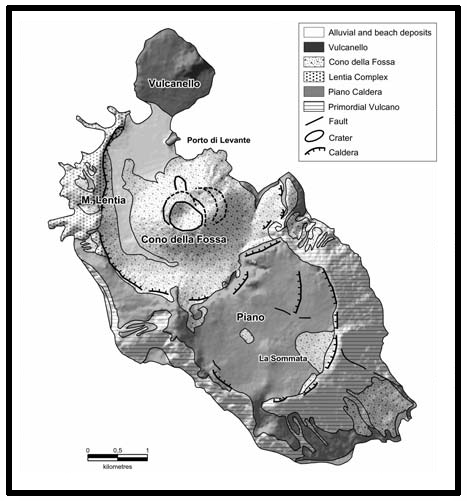Vulcano

Schematic geological map of Vulcano. Simplified after Keller (1980b).
The Island of Vulcano is exposed over an area of about 22 km2, and likely represents the southern sector of a larger volcanic complex, which includes both Vulcano and Lipari (Gioncada et al. 2003). The timing of the volcanic activity for the exposed rocks ranges between 120 ka and the present; the latest eruption dates back to 1888-1890 and the description made by Mercalli and Silvestri (1891) has been adopted as a basis to define vulcaniantype eruptions in the volcanological literature. Rock compositions range from mafic to silicic, with high-K calc-alkaline to shoshonitic and potassic alkaline (KS) affinities.
Volcanological and stratigraphic studies allowed identification of various stages of volcanic activity. Primordial Vulcano (120 to 100 ka) and Piano Caldera (100 and 20 ka) are a composite cone and a filled caldera, mostly formed by HKCA mafic to intermediate lava flows, pyroclastic rocks and dikes. The Lentia Complex (20 and 15 ka), sited north of Primordial Vulcano, is the remnant of a stratovolcano with a central caldera (Fossa Caldera), mainly formed by latitic, trachytic and rhyolitic lava flows, domes, and pyroclastic rocks. Fossa Caldera products were erupted between 15 and 8 ka by pyroclastic and effusive eruptions of shoshonitic intermediate to silicic magmas. Cono della Fossa is a 391 m high active edifice that rises at the center of the Fossa Caldera; it was formed in the last 6000 years by several silicic pyroclastic eruptions and a few lava effusions. Vulcanello is a shield made of mafic potassic lavas showing a KS affinity, with central trachytic pyroclastic cones. Vulcanello was formed as a new island probably about one thousand years ago; sand accumulation in the isthmus area finally connected Vulcanello with the main island.
the magmatism at Vulcano is characterised by an increase in the degree of rock chemical evolution with time. Potassium and incompatible elements also increase in the mafic magmas from older to younger activity. The time-related increase in the proportions of silicic vs. mafic magmas has been attributed to an enhanced role of fractional crystallization with respect to mafic magma input into the volcanic system. These effects are considered as related to an overall migration of magma chambers toward shallow levels. The variable enrichment in potassium and incompatible elements in mafic melts has been interpreted to indicate a heterogeneous mantle source, with early activity tapping deeper and less metasomatised mantle rocks than younger shoshonitic and KS volcanism. Melting at various levels in a stratified mantle would depend on isotherm upraise, which triggered melting at progressively shallower depth with time.
Bibliography
• Peccerillo. A. Plio-Quaternary Volcanism in Italy. (2005)



.jpg)
.jpg)
.jpg)
.jpg)
.jpg)
.jpg)
.jpg)
.jpg)
.jpg)
.jpg)
.jpg)
.jpg)
.jpg)
.jpg)
.jpg)
.jpg)
.jpg)
.jpg)
.jpg)